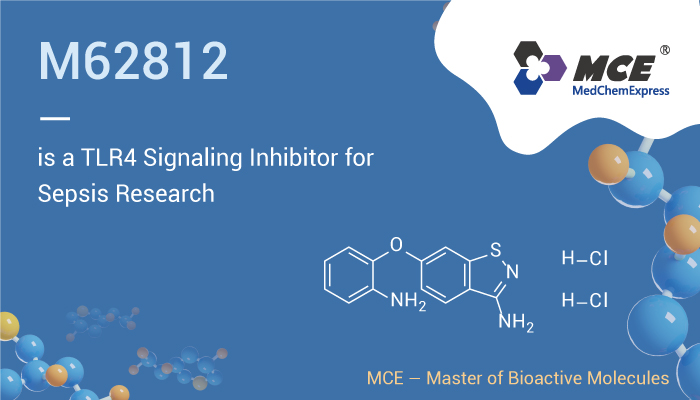Patients are often at risk for sepsis in intensive care units as a major complication after infection and/or surgery mostly due to trauma, burn injury, pancreatitis, etc. Sepsis occurs when microbes activate toll-like receptors (TLRs) stimulating widespread inflammation and activating coagulation cascades. In addition, overwhelming inflammatory and coagulatory responses are prominent features of sepsis and play a central role in the pathogenesis of tissue damage, multiple organ failure, and death. The morbidity and mortality of sepsis remain high despite extensive treatment with antibiotics, steroid hormones, fluid resuscitation and vasopressors. According to some studies, TLR4 signal transduction has been recognized as a key pathway for lipopolysaccharide (LPS)-induced activation of various cells and an attractive target for treatment of sepsis. Hence, we will introduce a TLR4 signaling inhibitor-M62812.

M62812 is a toll-like receptor 4 (TLR4) signaling inhibitor.
In vitro, M62812 (10 μg/mL; 6 h) completely inhibits LPS-induced NF-κB activation in NF-κB luciferase-expressing cells with an IC50 of 2.4 μg/mL. In addition, M62812 (3 μg/mL; 6 h) completely inhibits LPS-induced TNF-α production in peripheral blood mononuclear cells with an IC50 of 0.7 μg/mL. Besides, M62812 (3 μg/mL; 6 h) completely inhibits the production of IL-6 and E-selection in human endothelial cells with IC50s of 0.43 μg/mL and 1.4 μg/mL.
M62812 also shows good anti-inflammatory activity in vivo. M62812 (i.v.; 10-20 mg/kg; single dose) is protective and reduces inflammatory and coagulation parameters in a D-galactosamine-sensitized endotoxin shock mouse model. Moreover, M62812 (i.v.; 20 mg/kg; once a day for three days) prevents mice from lethality in a murine cecal ligation and puncture model.
All in all, M62812 not only inhibits endothelial and leukocyte activation, but also reduces LPS-induced coagulation and inflammatory responses. In other words, M62812 is a promising TLR4 signaling inhibitor for the research of sepsis.
Rererence:
[1] Nakamura M, et al. Eur J Pharmacol. 2007 Aug 27;569(3):237-43.